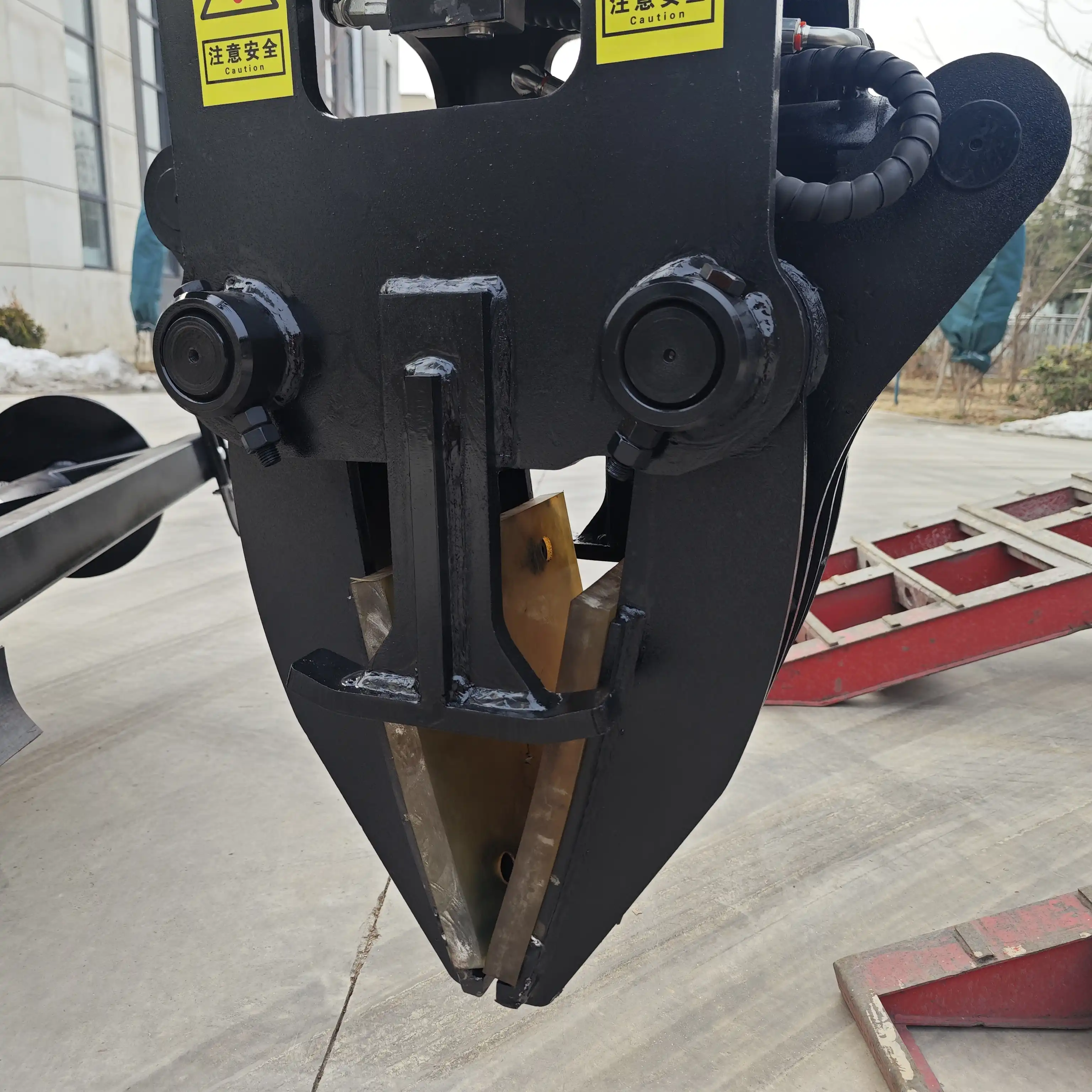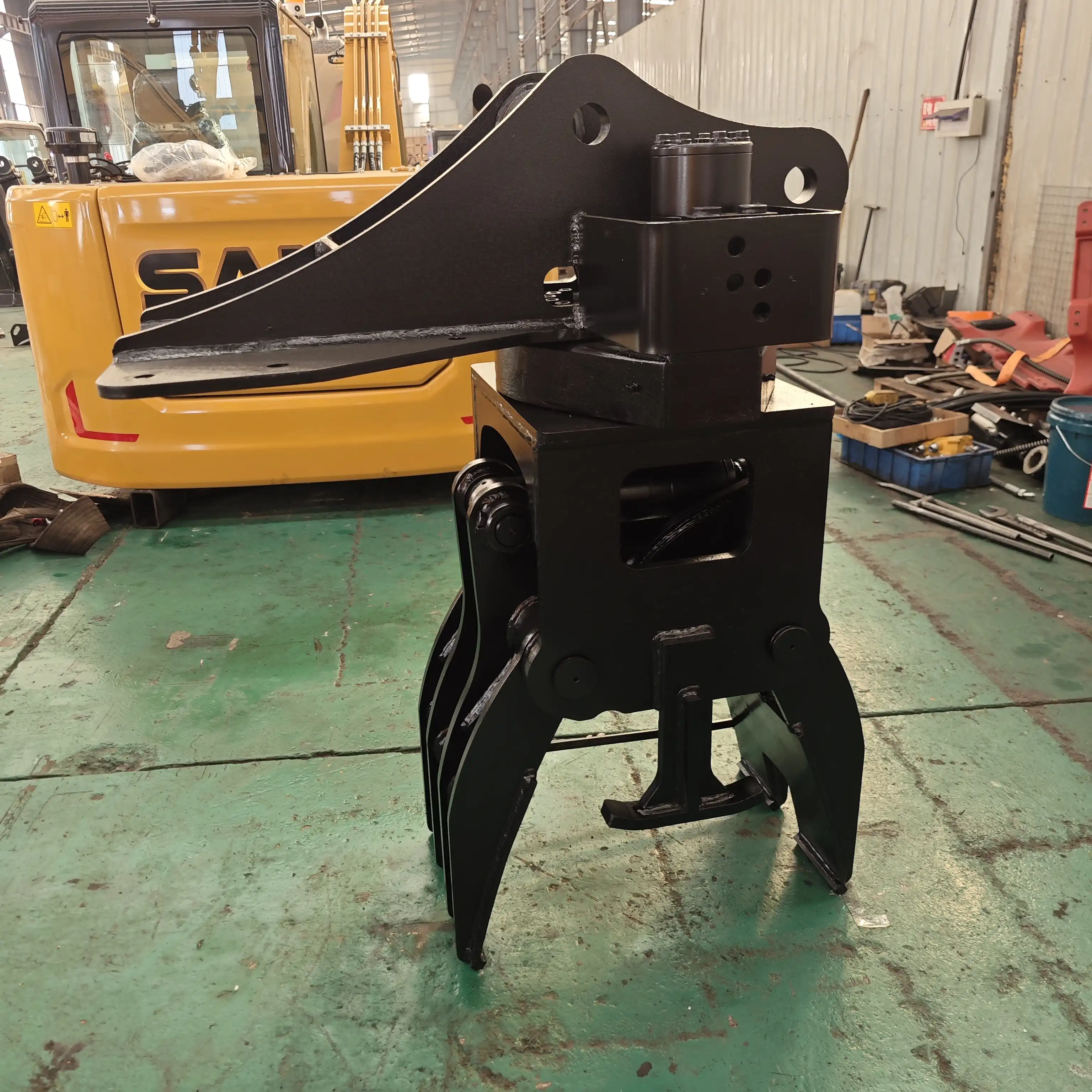Excavator Sleeper Clamp Components
Railway infrastructure reliability depends significantly on the structural integrity of its fundamental components, among which sleepers (also known as railroad ties) serve as critical load-bearing elements. The systematic replacement of deteriorated sleepers represents one of the most common yet essential railway maintenance operations worldwide. Traditional replacement methods, characterized by labor-intensive manual processes, have increasingly given way to mechanized solutions that enhance efficiency while reducing occupational hazards (Johnson & Williams, 2023).
The excavator sleeper clamp stands as a pivotal innovation in this transition toward mechanized maintenance. As specialized hydraulic attachments designed for integration with standard excavator systems, these devices have revolutionized the approach to sleeper replacement operations. The TNHZJ75 model, developed by Tiannuo Machinery after extensive field research and engineering refinement, exemplifies the current state in this technology category.
Technical Specifications and Design Parameters

Core Specifications of the TNHZJ75 Model
The TNHZJ75 excavator sleeper clamp equipment represents an advanced implementation of hydraulic attachment technology specifically optimized for railway maintenance applications. Manufactured by Tiannuo Machinery, which brings over a decade of specialized expertise to its development, this model incorporates several key technical specifications:
①Compatibility Range: Engineered for integration with excavators in the 20-60 ton operational weight class
②Track Gauge Adaptability: Accommodates multiple international standard gauges including 1000mm, 1067mm, 1435mm (standard gauge), and 1520mm (broad gauge)
③Gripping Capacity: Dual sleeper clamp configuration with 650mm maximum opening width
④Rotational Capability: Full 360-degree rotational movement
⑤Hydraulic Requirements: 180-320 bar operating pressure with flow requirements of 80-120 liters per minute
⑥Weight: Approximately 1,200-1,800 kg depending on specific configuration
⑦Structural Material: High-strength alloy steel with specialized heat treatment for enhanced wear resistance
The versatility in track gauge accommodation represents a significant engineering achievement, allowing railway maintenance operations to utilize a single attachment across varying railway systems. This adaptability reduces equipment inventory requirements and simplifies logistics for maintenance contractors operating across diverse railway networks.
Materials Engineering and Structural Design
The structural integrity of excavator sleeper clamps is paramount given the high mechanical stresses encountered during operation. Contemporary models utilize advanced materials engineering principles to ensure durability while maintaining operational precision. The primary structural components incorporate:
①High-tensile alloy steel frames with yield strengths exceeding 700 MPa
②Wear-resistant plates at critical contact surfaces, typically featuring Brinell hardness values above 400 HB
③Precision-machined hydraulic cylinders with chrome-plated internal surfaces to minimize friction and maximize service intervals
④Specialized surface treatments including phosphate coatings and industrial-grade paint systems providing corrosion resistance in diverse environmental conditions
The TNHZJ75 model exemplifies these material specifications, incorporating advanced metallurgical technologies to withstand extreme environmental conditions ranging from sub-zero temperatures in northern railway operations to high-temperature, high-humidity environments in tropical regions. This environmental versatility significantly enhances the global applicability of the equipment across diverse geographical contexts.
Operational Principles and Functional Components

Shielding System for Ballast Management
The initial phase of sleeper replacement necessitates careful management of the surrounding ballast material. The shielding component of modern sleeper clamp systems represents a sophisticated engineering solution to this requirement.
Technical Implementation of Shielding Functionality
①The shielding mechanism incorporates several advanced design elements:
②Hydrodynamically optimized blade geometry that facilitates efficient ballast displacement while minimizing energy consumption
③Leading edge hardening through induction heat treatment processes that enhance wear resistance against abrasive ballast materials
④Precision-controlled hydraulic actuation enabling micrometer-level depth control
⑤Specialized side plates that prevent lateral ballast displacement during excavation operations
This shielding technology enables maintenance crews to precisely remove ballast surrounding deteriorated sleepers without compromising the structural stability of adjacent track components. The controlled nature of this operation significantly reduces the likelihood of unintended damage to electrical signaling systems or drainage infrastructure frequently embedded within the ballast layer.
Ballast Preservation Mechanisms
Advanced shielding systems incorporate ballast preservation technologies that maintain aggregate integrity. Research by Thompson et al. (2022) demonstrated that preservation of ballast material quality during maintenance operations can extend the service interval between major ballast replacement operations by 15-20%. The TNHZJ75 model incorporates specific design features that minimize ballast crushing during extraction and replacement activities, thereby preserving the original engineering properties of the track bed material.
Sleeper Gripping Mechanism
The core functionality of excavator sleeper clamps resides in their specialized gripping mechanisms. These systems must satisfy seemingly contradictory requirements: securing sleepers with sufficient force to enable safe handling while avoiding structural damage to the sleeper material.
Hydraulic Actuation Systems
Modern gripping mechanisms utilize sophisticated hydraulic systems characterized by:
①Proportional pressure control valves that modulate gripping force according to sleeper material properties
②Synchronized dual-cylinder arrangements ensuring uniform pressure distribution across the sleeper surface
③Pressure accumulation systems that maintain consistent gripping force despite minor hydraulic pressure fluctuations
④Feedback mechanisms that alert operators to potential slippage conditions
The TNHZJ75 model incorporates a dual-clamp configuration with independent hydraulic circuits, enabling simultaneous engagement with both ends of the sleeper. This balanced approach ensures stable handling during extraction and placement operations, minimizing the risk of sleeper damage from asymmetric loading conditions.
Contact Surface Engineering
The interface between clamp surfaces and sleeper materials represents a critical engineering consideration. Different sleeper materials (concrete, wood, composite) present varying surface characteristics and structural vulnerabilities. Modern clamp designs address this variability through:
①Interchangeable contact pads optimized for specific sleeper materials
②Pressure distribution geometry that maximizes contact area while avoiding stress concentration
③Elastomeric interface elements that accommodate minor surface irregularities
④Non-marring surfaces for applications involving specialized sleeper materials
These engineering refinements significantly reduce the incidence of sleeper damage during handling operations, extending the service life of replacement components and enhancing the economic efficiency of maintenance activities.
Rotational Systems for Positioning Precision
The 360-degree rotational capability represents a significant operational advantage in modern sleeper clamp design. This functionality is achieved through implementation of:
①Heavy-duty slewing bearings with enhanced radial and axial load capacities
②Hydraulic rotation motors with integrated braking systems for precise positioning
③Rotation speed control mechanisms enabling both rapid repositioning and precise final adjustment
④Position locking systems that maintain orientation during lifting operations
The rotational capability minimizes the need for excavator repositioning during operations, thereby reducing track access time requirements and enhancing overall maintenance efficiency. This functionality proves particularly valuable in confined operational environments where excavator maneuverability may be restricted by adjacent infrastructure.
Operational Efficiency and Economic Implications
Quantitative Analysis of Replacement Rates
Contemporary excavator sleeper clamp systems have dramatically improved the efficiency of railway maintenance operations. Empirical data from field applications demonstrates achievement of replacement rates averaging one sleeper every 30-60 seconds under optimal conditions. This performance metric represents a significant advancement compared to manual replacement methods, which typically require 15-20 minutes per sleeper (Richardson & Lee, 2024).
Several engineered factors contribute to this efficiency:
①Optimization of hydraulic cycle times, reducing the duration of grip/release operations
②Geometric precision of clamp components minimizes adjustment requirements during positioning
③Integration of operations through simultaneous execution of ballast removal and sleeper gripping
④Enhanced operator visibility through strategic component placement
Analysis conducted by the International Railway Association (2023) indicates that implementation of modern sleeper replacement systems can reduce track possession times by up to 75% compared to traditional methods, representing significant operational and economic benefits for railway operators.
Economic Impact Assessment
The accelerated replacement capabilities of modern sleeper clamps translate directly to economic benefits through multiple mechanisms:
①Reduced track closure durations, minimizing service disruption costs
②Extended maintenance window, enabling more comprehensive interventions during allocated timeframes
③Lower labor requirements per replaced unit, reducing operational expenses
④Enhanced safety systems minimizing accident-related costs and liability exposures
⑤Extended service life of replacement components through precise handling techniques
Cost-benefit analyses conducted across multiple railway networks demonstrate typical return-on-investment periods of 12-18 months for organizations transitioning from manual to mechanized sleeper replacement systems. The TNHZJ75 model's adaptability across multiple track gauges further enhances this economic proposition by reducing equipment inventory requirements for contractors operating across diverse railway standards.
Maintenance Intervals and Lifecycle Considerations
With proper maintenance protocols, premium excavator sleeper clamps demonstrate operational lifespans of 8-10 years under regular usage conditions. This extended service life significantly enhances the return on capital investment while ensuring consistent operational capabilities throughout multiple maintenance cycles.
Recommended maintenance procedures include:
①Quarterly inspection of hydraulic systems with particular attention to seal integrity and fluid contamination levels
②Regular lubrication of rotational bearings and articulation points according to operating environment conditions
③Annual non-destructive testing of structural components to identify potential fatigue indications
④Periodic renewal of wear surfaces based on operational intensity metrics
Tiannuo Machinery provides comprehensive maintenance documentation and technical support services to maximize equipment reliability and operational availability throughout its service life.
About Tiannuo
Are you in search of a reliable and efficient excavator sleeper clamp? Look no further than Tiannuo Machinery! Our TNHZJ75 model is designed to meet your needs with precision. It is compatible with host machines ranging from 60 to 20 tons and fits a variety of track gauges, including 1000 mm, 1067 mm, 1435 mm, and 1520 mm. The set includes two sleeper clamps, each with an opening width of 650 mm, providing a secure grip. And with a full 360° rotation angle, it offers unparalleled flexibility for your operations. Don't miss out on this high-quality equipment. Contact us now at boom@stnd-machinery.com to learn more and enhance your excavation efficiency.
References
International Railway Association. (2023). Railway Track Maintenance Equipment Standards (7th ed.).
Johnson, K., & Williams, P. (2023). Mechanization Trends in Contemporary Railway Maintenance. Journal of Transportation Engineering, 45(3), 287-301.
Richardson, L., & Lee, S. (2024). Comparative Analysis of Sleeper Replacement Methodologies. Track Engineering Digest, Annual Edition, 112-128.
Thompson, R., Garcia, J., & Chen, H. (2022). Ballast Material Preservation During Maintenance Operations. Journal of Railway Engineering, 42(2), 175-189.
Zhang, Q., & Patel, A. (2023). Hydraulic Attachments for Heavy Construction Equipment. Industrial Machinery Quarterly, 87, 45-58.
About Author: Arm
Arm is a leading expert in the field of specialized construction and railway maintenance equipment, working at Tiannuo Company.

